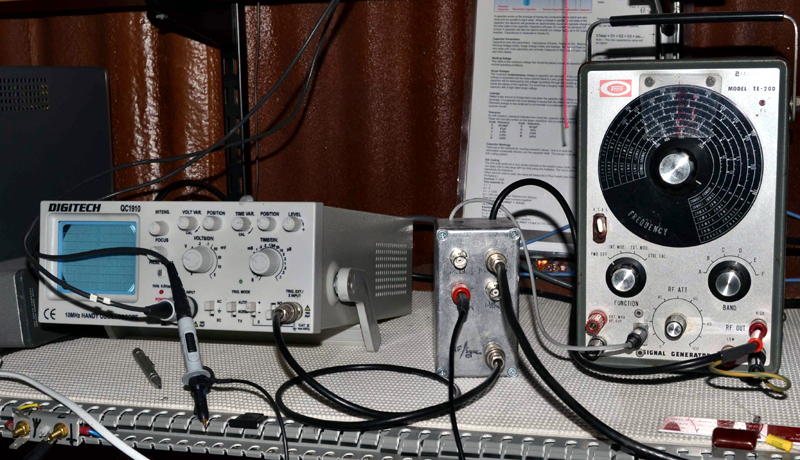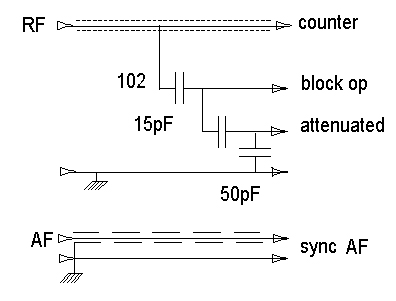Workshops, Tools and Test Equipment
Forum home - Go back to Workshops, Tools and Test Equipment
|
Coupling box & attenuator
|
|
|
« Back ·
1 ·
Next »
|
|
|
Return to top of page · Post #: 1 · Written at 12:01:19 AM on 5 November 2014.
|
|
|
|
Location: Wangaratta, VIC
Member since 21 February 2009 Member #: 438 Postcount: 5632 |
|
This is from a request from a post re11-20 Kriesler.   There really is not much to this black box as it's main function is to direct traffic by taking the outputs from the sig gen & distributing them, to mainly BNC so that they can couple via coax so there is no signal radiating everywhere. Box is metal because of RF The sig gen I have is a clone of an LSG-11 and I have one of those and it's original box. The main difference between the LSG & Clone is that one (LSG) has a 0.001 cap before its attenuator & that causes the counter grief, when it cannot get enough input. That is another reason for the black box. It puts the counter before the cap that has to be added to the clone but on the LSG reduces the signal needed by the counter. It would be nice to have a generator with a counter that does not need some of this. But when the OP is around 0.1V, or more & you need micro volts & DC blocking, you need to attenuate. The sig gen can be modulated from an external source but I found that as it outputs audio I could use that on the CRO's external sync to give a more stable picture. I prefer the CRO during alignment as it is more sensitive & can see distortion, as well as being a great signal tracer when things go pear shaped. As will be seen RF in goes direct to the counter, which should not be calibrated with the "tone" on .. Then there is the DC blocking cap, followed by the next stage of attenuation. Note there are two outputs for that. viz BNC & banana plug. Marc |
|
|
Return to top of page · Post #: 2 · Written at 7:56:49 PM on 5 November 2014.
|
|
|
|
Location: Sydney, NSW
Member since 28 January 2011 Member #: 823 Postcount: 6896 |
|
Good idea. I like it. |
|
|
Return to top of page · Post #: 3 · Written at 10:16:01 PM on 5 November 2014.
|
|
|
|
Location: Central Coast, NSW
Member since 18 April 2014 Member #: 1554 Postcount: 215 |
|
Very tidy Idea Marc |
|
|
Return to top of page · Post #: 4 · Written at 11:14:08 PM on 5 November 2014.
|
|
|
|
Location: Wangaratta, VIC
Member since 21 February 2009 Member #: 438 Postcount: 5632 |
|
Just for valve radio, alignment I would agree that if the generator is as I said, its good enough with the frequency counter calibrating it. |
|
|
Return to top of page · Post #: 5 · Written at 11:21:17 PM on 5 November 2014.
|
|
|
|
Location: Sydney, NSW
Member since 28 January 2011 Member #: 823 Postcount: 6896 |
|
that mostly uncapped duct is there to hold tweezers chopsticks, scissors, probes & anything else that fits in the grooves |
|
|
Return to top of page · Post #: 6 · Written at 12:34:25 PM on 6 November 2014.
|
|
|
|
Location: Wangaratta, VIC
Member since 21 February 2009 Member #: 438 Postcount: 5632 |
|
Duct is handy: It keeps wire under control. There is wider fully capped duct on the shelf edge above the computers and it carries wires for printers, scanners, hubs, & corded rat, preventing them from being a massive tangle behind the screens & stress relieving wires from an engine that is actually on a shelf to keep it off the bench & above the floor dust. |
|
|
Return to top of page · Post #: 7 · Written at 12:41:31 PM on 6 November 2014.
|
|
|
|
Administrator
Location: Naremburn, NSW
Member since 15 November 2005 Member #: 1 Postcount: 7571 |
|
double adapters for BNC ‾‾‾‾‾‾‾‾‾‾‾‾‾‾‾‾‾‾‾‾‾‾‾‾‾‾‾‾‾‾‾‾‾‾‾‾‾‾‾‾‾‾‾‾‾‾‾‾‾‾‾‾‾‾‾‾‾‾‾‾‾‾‾‾‾‾‾‾ A valve a day keeps the transistor away... |
|
|
Return to top of page · Post #: 8 · Written at 10:38:40 PM on 7 November 2014.
|
|
|
|
Location: Somewhere, USA
Member since 22 October 2013 Member #: 1437 Postcount: 896 |
|
Hi, Can you provide any info on the Siggen including year? |
|
|
Return to top of page · Post #: 9 · Written at 11:27:09 PM on 7 November 2014.
|
|
|
|
Location: Wangaratta, VIC
Member since 21 February 2009 Member #: 438 Postcount: 5632 |
|
Electrically, the only difference between the TED-20 & the LSG -11 is the output arrangement. Same valves same Colpitts oscillator. |
|
|
Return to top of page · Post #: 10 · Written at 2:20:08 PM on 8 November 2014.
|
|
|
|
Location: Somewhere, USA
Member since 22 October 2013 Member #: 1437 Postcount: 896 |
|
Thanks, I thought it might be solid state. There's a massive ugly difference with regard to mine. |
|
|
Return to top of page · Post #: 11 · Written at 2:34:07 PM on 8 November 2014.
|
|
|
|
Location: Wangaratta, VIC
Member since 21 February 2009 Member #: 438 Postcount: 5632 |
|
Yes, same as... I did repair & sort out the cable on this one as it was 2 wire & its a metal case. Compared to the photo & the fact this one was in its own box mine is an A category. |
|
|
Return to top of page · Post #: 12 · Written at 4:13:16 AM on 10 November 2014.
|
|
|
|
Location: Central Coast, NSW
Member since 18 April 2014 Member #: 1554 Postcount: 215 |
|
Thanks Guys. |
|
|
Return to top of page · Post #: 13 · Written at 10:36:56 PM on 10 November 2014.
|
|
|
|
Location: Wangaratta, VIC
Member since 21 February 2009 Member #: 438 Postcount: 5632 |
|
I was going to post a reply earlier but the system fell over? |
|
|
« Back ·
1 ·
Next »
|
|
|
You need to be a member to post comments on this forum.
|
|

Sign In

Vintage Radio and Television is proudly brought to you by an era where things were built with pride and made to last.
DISCLAIMER: Valve radios and televisions contain voltages that can deliver lethal shocks. You should not attempt to work on a valve radio or other electrical appliances unless you know exactly what you are doing and have gained some experience with electronics and working around high voltages. The owner, administrators and staff of Vintage Radio & Television will accept no liability for any damage, injury or loss of life that comes as a result of your use or mis-use of information on this website. Please read our Safety Warning before using this website.
WARNING: Under no circumstances should you ever apply power to a vintage radio, television or other electrical appliance you have acquired without first having it checked and serviced by an experienced person. Also, at no time should any appliance be connected to an electricity supply if the power cord is damaged. If in doubt, do not apply power.
Shintara - Keepin' It Real · VileSilencer - Maintain The Rage

